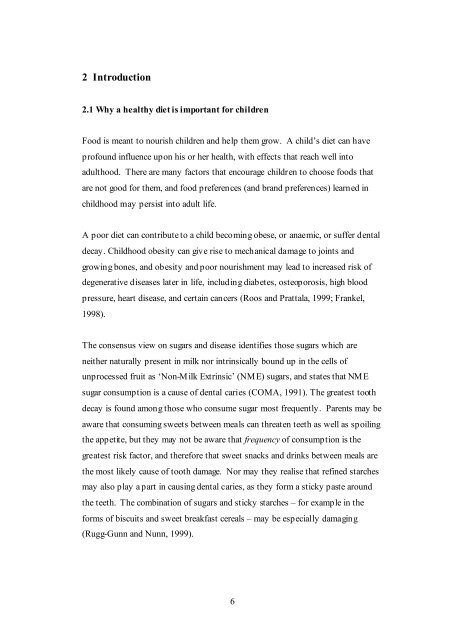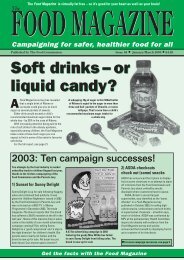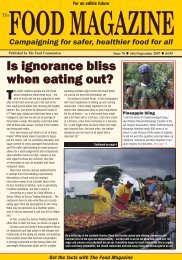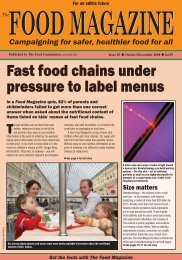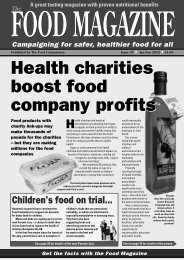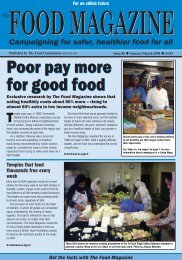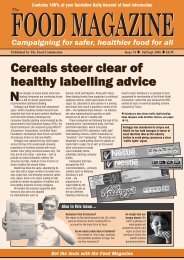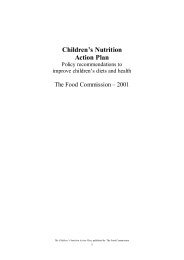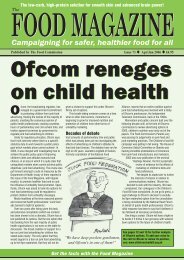To view the full report Children's Food Examined in PDF format click ...
To view the full report Children's Food Examined in PDF format click ...
To view the full report Children's Food Examined in PDF format click ...
Create successful ePaper yourself
Turn your PDF publications into a flip-book with our unique Google optimized e-Paper software.
2 Introduction2.1 Why a healthy diet is important for children<strong>Food</strong> is meant to nourish children and help <strong>the</strong>m grow. A child’s diet can haveprofound <strong>in</strong>fluence upon his or her health, with effects that reach well <strong>in</strong>toadulthood. There are many factors that encourage children to choose foods thatare not good for <strong>the</strong>m, and food preferences (and brand preferences) learned <strong>in</strong>childhood may persist <strong>in</strong>to adult life.A poor diet can contribute to a child becom<strong>in</strong>g obese, or anaemic, or suffer dentaldecay. Childhood obesity can give rise to mechanical damage to jo<strong>in</strong>ts andgrow<strong>in</strong>g bones, and obesity and poor nourishment may lead to <strong>in</strong>creased risk ofdegenerative diseases later <strong>in</strong> life, <strong>in</strong>clud<strong>in</strong>g diabetes, osteoporosis, high bloodpressure, heart disease, and certa<strong>in</strong> cancers (Roos and Prattala, 1999; Frankel,1998).The consensus <strong>view</strong> on sugars and disease identifies those sugars which arenei<strong>the</strong>r naturally present <strong>in</strong> milk nor <strong>in</strong>tr<strong>in</strong>sically bound up <strong>in</strong> <strong>the</strong> cells ofunprocessed fruit as ‘Non-Milk Extr<strong>in</strong>sic’ (NME) sugars, and states that NMEsugar consumption is a cause of dental caries (COMA, 1991). The greatest toothdecay is found among those who consume sugar most frequently. Parents may beaware that consum<strong>in</strong>g sweets between meals can threaten teeth as well as spoil<strong>in</strong>g<strong>the</strong> appetite, but <strong>the</strong>y may not be aware that frequency of consumption is <strong>the</strong>greatest risk factor, and <strong>the</strong>refore that sweet snacks and dr<strong>in</strong>ks between meals are<strong>the</strong> most likely cause of tooth damage. Nor may <strong>the</strong>y realise that ref<strong>in</strong>ed starchesmay also play a part <strong>in</strong> caus<strong>in</strong>g dental caries, as <strong>the</strong>y form a sticky paste around<strong>the</strong> teeth. The comb<strong>in</strong>ation of sugars and sticky starches – for example <strong>in</strong> <strong>the</strong>forms of biscuits and sweet breakfast cereals – may be especially damag<strong>in</strong>g(Rugg-Gunn and Nunn, 1999).6


